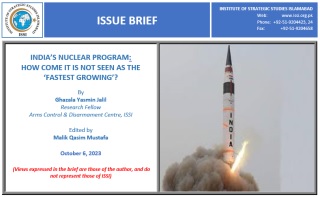The Bulletin of Atomic Scientists recently published the Nuclear Weapons of Pakistan, 2023 report. Among other things, it also published an estimate of Pakistan’s nuclear arsenal amounting to 170 warheads, as well as details of Pakistan’s doctrine and delivery systems.[1] These estimates are exaggerated and based on dubious data and information. Over the years, there have been countless Western analyses that have dubbed Pakistan as the “fastest growing” nuclear program. Moreover, there have been questions raised over the safety and security of Pakistan’s nuclear program. However, one would hardly see any Western comments or analyses over India’s nuclear arsenal, its pursuit of a thermonuclear bomb, its unbridled pursuit of delivery systems and a nuclear triad, its lax nuclear safety and security record, or even the pursuit of hypersonic missiles or purchase of ballistic missile systems like the S-400. The allegedly “accidental” launch of a nuclear-capable Brahmos missile into Pakistani territory[2] was also treated by Western commentators and the White House as if it was business as usual. Is Pakistan indeed building up its nuclear arsenal at a fast pace or is it India that is growing its nuclear arsenal and offensive capabilities at a tremendous pace but no light shines on it?
Indian Nuclear Program
India is pursuing a triad of nuclear forces deployed on aircraft, land-based missiles, and nuclear-powered ballistic missile submarines. Its missile force is comprised of ballistic, cruise missiles, and intercontinental ballistic missiles (ICBMs) like Agni V on land, which can cover all of Pakistan, parts of China, and beyond with a range of over 5000 km. At sea, it is developing and fielding a 700 km range K-15 Sagarika submarine-launched ballistic missile (SLBM), the short-range Dhanush, and the supersonic cruise missile Brahmos. India already has two nuclear-powered submarines operational and plans to deploy another four in the next decade. It has nuclearized the Indian Ocean, taking the nuclear competition to the sea with the associated command and control issues, increased readiness of nuclear weapons, the increased risk of misperception and accidental nuclear launch. There are also indications that India is abandoning a policy of ‘No First Use’ (NFU) and pursuing a preemptive counterforce doctrine against Pakistan.[3] India is also pursuing a ballistic missile defence system – which is a mixture of indigenous and acquired systems like the Russian S-400. The latest of Indian pursuits is the hypersonic missiles, which due to their supersonic speed and maneuverability will further reduce the missile flight times between India and Pakistan.[4] This unchecked pursuit of nuclear triad, BMD systems, and hypersonic missiles makes nuclear deterrence unstable and tremendously increases the risk of conflict in South Asia.
















